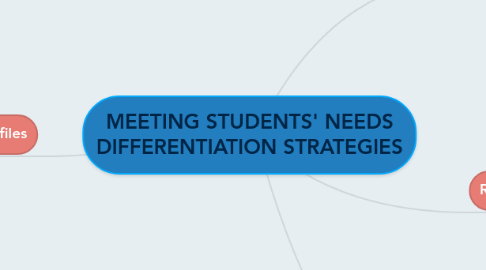
1. Learning Profiles
1.1. Visual Learners
1.1.1. Characteristics
1.1.1.1. Easily visualizes objects
1.1.1.2. Great sense of balance
1.1.1.3. Instinctively follows directions
1.1.1.4. Excellent organizers
1.1.2. Strategies
1.1.2.1. Students who identify themselves as visual learners could benefit from the following strategies to meet the objective...
1.1.2.1.1. Present information in graphic organizers or infographics, when talking about their daily routine
1.1.2.1.2. Make flashcards in which the character is accompanied by a drawing, colors and figures that help students remember.
1.2. Kinesthetic Learners
1.2.1. Characteristics
1.2.1.1. Quick reactions
1.2.1.2. Excellent motor memory
1.2.1.3. Experimenters
1.2.1.4. Good at sports, art and drama
1.2.1.5. High energy levels
1.2.2. Strategies
1.2.2.1. Have your kinesthetic learners perform tasks during the lecture like filling out a worksheet on the material or taking notes. It will help them focus even if it's just their hand moving. Allow those students to perform movement tasks before and after lectures like passing back assignments, handing out quizzes, writing on the chalkboard, or even rearranging desks.
1.2.2.2. Kinesthetic learners can present information by acting out or even mimic some movements to tell a story.
1.2.2.3. They can also benefit from games and activities that require them to move. Typing information (in Chinese characters) in the computer while listening a a dialogue can help them concentrate and quickly respond to stimuli.
1.3. Auditory Learners
1.3.1. Characteristics
1.3.1.1. Easily remember what is heard or said
1.3.1.2. Enjoys small group discussions
1.3.1.3. Remembers oral instructions well
1.3.1.4. Easily processes information that has been heard
1.3.2. Strategies
1.3.2.1. Study with a friend so you can talk about the information and HEAR it, too. Recite out loud the information you want to remember several times. Ask your teacher if you can submit some work (if appropriate) as an oral presentation, or on audio tape. Make your own tapes of important points you want to remember and listen to it repeatedly. This is especially useful for learning material for tests. When reading, skim through and look at the pictures, chapter titles, and other clues and say out loud what you think this book could be about. Make flashcards for various material you want to learn and use them repeatedly, reading them out loud. Use different colours to aid your memory. Set a goal for your assignments and verbalise them. Say your goals out loud each time you begin work on that particular assignment.
1.3.2.2. Auditory learners can also benefit from doing flashcards since those give them a visual support to complement their auditory skills.
1.3.2.3. Auditory learners can pair up with visual learners to record information that is being heard. They would do a great team and can organize the information more efficiently
2. Interests
2.1. Strategies
2.1.1. As we talk about daily routines, each student has the freedom to include the activities that they like the most and explain when and for how long they do them.
2.1.2. Students can present their daily routines by recording a video, an audio file, designing a poster, a comic book or as a written paragraph.
2.2. Why is it important?
2.2.1. Student interest in a topic holds so much power. When a topic connects to what students like to do, engagement deepens as they willingly spend time thinking, dialoging, and creating ideas in meaningful ways. Making learning contextual to real-world experiences is a key learning technique with differentiating for student interests.
3. Readiness
3.1. Readiness refers to ensuring that all learners are given complex work that is respectful of their current skill levels.
3.1.1. Beginner
3.1.1.1. Can retell information using shorter sentences as long as the verb and complement are used correctly. I have some students that arrived late in the school year and missed a couple of lessons. They are in the process of catching up and still do not master some of the basic vocabulary from previous lessons
3.1.2. Intermediate
3.1.2.1. Can retell information using complete sentences with an extra support from the teacher or one of their peers. These student can use flashcards that remind them the structure of the sentences when retelling the information.
3.1.3. Advanced
3.1.3.1. Can retell information using complete sentences with ease. These students are also encouraged to provide extra information and longer sentences.

